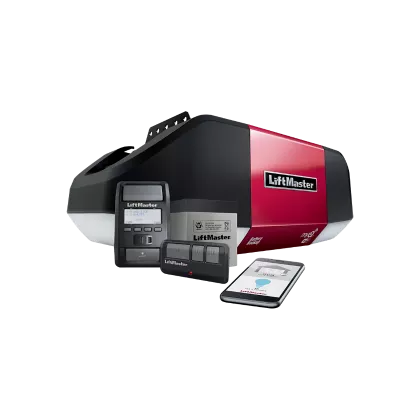If it’s time to for you to purchase a new electric garage door opener, be aware that there are different types. The drive mechanism (considered its transmission) can be based on a chain (much like the one on your bicycle), on a rubber belt (reinforced with steel as with car tires), on a screw (not as popular in cold regions), and the latest model, the Jackshaft, installed next to the door.
Curious as to which is best? It really comes down to your requirements. However, for some specific applications and to satisfy certain needs, an opener equipped with a belt drive will be the one most often suggested. Read on to learn why.

Before getting started, a little more background information
We need to talk about the difference between the AC or DC motors that control the opener. A direct current (or DC) motor starts slowly, increases to its normal speed, then slows at the end of its route. On the other hand, an alternating current (AC) motor maintains a constant speed. Is one of these types of motor faster than the other? Not really. Both motors raise and lower the door at about 6 to 8 inches (16 to 20 cm) a second, depending on the model of opener.
Is this feature, AC or DC, important? Most certainly yes, if the noise caused by the motor can bother you. DC-type motors are quieter. For DC motors, we can also add the ability to use a back-up battery, which we are unable to do with an AC-type motor.
How do they work?
To start, let us establish that we are talking about a door opener with a central trolley. This means it is installed on the ceiling at the middle of the door. The belt that opens and closes the door is made primarily of rubber reinforced with metal wires, similar to steel-belted radial tires. Some manufacturers may also use fiberglass or polyurethane as components in producing the belt.
This rubber-based “loop” runs along a T-shaped track on the ceiling. Its tension can be adjusted with a simple wrench to ensure it operates properly. To complete your door opener, you can purchase either a ½ or ¾ HP (horsepower) motor. If your garage door is double, for example 16 feet wide, a ¾ HP door opener is suggested. For a single door, 8 to 9 feet wide, ½ HP is quite enough.
Always keep one key fact in mind: a door opener is only a replacement for human strength, and that a garage door must always be correctly balanced making its weight seem between 8 and 10 lb. (3.5 and 4 kilos). This means that you have to always be able to lift your garage door, once it is disengaged from the opener, with only one hand. If not, you have pinpointed a serious issue.
What are the advantages of a belt drive opener?
The biggest advantage of an opener fitted with a belt drive is the fact that it is much quieter than a chain-drive opener. More specifically, it is at least 25 to 30% quieter. For a home with an attached garage with a room, often a bedroom, located directly above it, an opener with a rubber belt would be the best investment. What’s more, if you request a DC motor, like LiftMaster’s 8550W, you’ll have an added factor for it to be as quiet as possible.

Does the simple fact of having a rubber belt make the opener quieter? Not completely. It is also the fact that it ensures fluid movement, movement without vibration or oscillation. There is also the construction of the housing for the opener motor that can reduce noise transmission.
You say, everything, even the most perfect product, has a drawback. So then what is the main disadvantage of a belt drive? The answer is – its price. It is somewhat more expensive than a chain-drive opener, especially if that drive is equipped with a trolley made in 3 sections, the type often found in big box stores. Is it worth investing more to reduce the noise 25 to 30%? YES… especially if you don’t like being woken up by garage door noise in the middle of the night.
Are there other things that can be done to reduce the noise coming from the opener as much as possible? Yes!
If the opener is mounted on wood joists, secure it.
A strip of semi-rigid rubber installed between the steel angle and the wood joist will reduce noise transmission. There is also a vibration isolation kit that goes between the steel angle and the opener housing. This works in a similar way to rubber vibration isolators between a car’s chassis and its engine.
Use nylon rollers.
When compared to metal rollers, nylon ones, in either black or white, are a major factor.
Lubricate steel parts (hinges, track curves).
Twice-yearly lubrication with motor oil, such as 5W30, will help to reduce noise. By the way, those door openers fitted with rubber belt drives are NOT to be lubricated. When they were originally installed, the technician lubricated the drive sprockets, located at each end of the belt, with grease recommended by the manufacturer, and you don’t have to worry about this for at least 5 to 7 years.
If you have wood floors in the bedroom over the garage.
A bedroom with a wood floor can become a real echo chamber. Install carpeting or rugs to dampen the transfer of sounds.
Install a Jackshaft door opener.
If there is space beside to allow it, instead of installing a ceiling door opener, put an opener on the side wall, thus eliminating the transmission of sound to the wood joists.
Realize that there is not one single action you can take that will considerably reduce the noise transferred by the door system, but rather the combination of some of them. Talk to an experienced technician at Crosby Garage Doors.
I’m convinced – now, what should I do?
Then go right ahead and contact us at 724-834-8450. We are the experts who know garage door openers better than anyone else because we know all the brands available on the market and can make the best possible recommendation. We can as well email you a quotation.


Add new comment